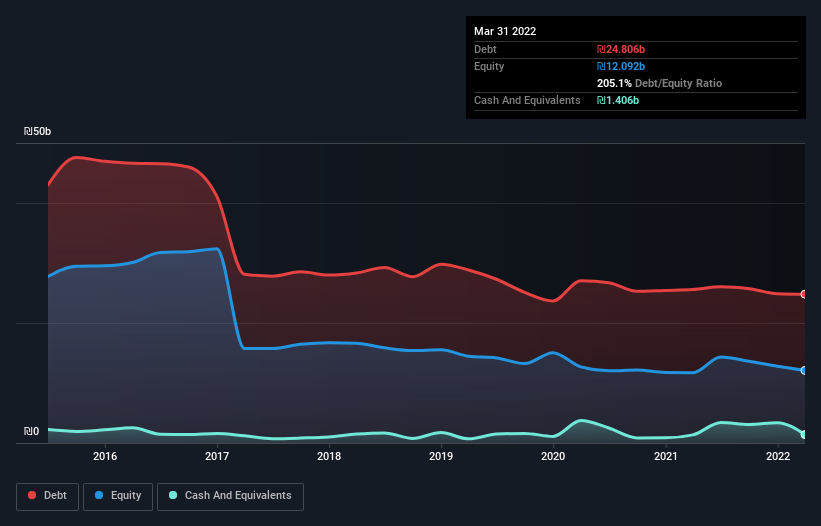
David Iben put it well when he said, 'Volatility is not a risk we care about. What we care about is avoiding the permanent loss of capital.' When we think about how risky a company is, we always like to look at its use of debt, since debt overload can lead to ruin. We can see that Norstar Holdings Inc. (TLV:NSTR) does use debt in its business. But the more important question is: how much risk is that debt creating?
What Risk Does Debt Bring?
Debt assists a business until the business has trouble paying it off, either with new capital or with free cash flow. Part and parcel of capitalism is the process of 'creative destruction' where failed businesses are mercilessly liquidated by their bankers. However, a more usual (but still expensive) situation is where a company must dilute shareholders at a cheap share price simply to get debt under control. Of course, debt can be an important tool in businesses, particularly capital heavy businesses. The first step when considering a company's debt levels is to consider its cash and debt together.
See our latest analysis for Norstar Holdings
How Much Debt Does Norstar Holdings Carry?
As you can see below, Norstar Holdings had ₪24.8b of debt, at March 2022, which is about the same as the year before. You can click the chart for greater detail. However, because it has a cash reserve of ₪1.41b, its net debt is less, at about ₪23.4b.

How Strong Is Norstar Holdings' Balance Sheet?
According to the last reported balance sheet, Norstar Holdings had liabilities of ₪3.60b due within 12 months, and liabilities of ₪24.8b due beyond 12 months. On the other hand, it had cash of ₪1.41b and ₪666.0m worth of receivables due within a year. So its liabilities outweigh the sum of its cash and (near-term) receivables by ₪26.3b.
This deficit casts a shadow over the ₪1.22b company, like a colossus towering over mere mortals. So we definitely think shareholders need to watch this one closely. At the end of the day, Norstar Holdings would probably need a major re-capitalization if its creditors were to demand repayment.
We measure a company's debt load relative to its earnings power by looking at its net debt divided by its earnings before interest, tax, depreciation, and amortization (EBITDA) and by calculating how easily its earnings before interest and tax (EBIT) cover its interest expense (interest cover). The advantage of this approach is that we take into account both the absolute quantum of debt (with net debt to EBITDA) and the actual interest expenses associated with that debt (with its interest cover ratio).
Norstar Holdings shareholders face the double whammy of a high net debt to EBITDA ratio (18.8), and fairly weak interest coverage, since EBIT is just 0.98 times the interest expense. This means we'd consider it to have a heavy debt load. The good news is that Norstar Holdings improved its EBIT by 7.3% over the last twelve months, thus gradually reducing its debt levels relative to its earnings. The balance sheet is clearly the area to focus on when you are analysing debt. But it is Norstar Holdings's earnings that will influence how the balance sheet holds up in the future. So if you're keen to discover more about its earnings, it might be worth checking out this graph of its long term earnings trend.
But our final consideration is also important, because a company cannot pay debt with paper profits; it needs cold hard cash. So it's worth checking how much of that EBIT is backed by free cash flow. In the last three years, Norstar Holdings's free cash flow amounted to 33% of its EBIT, less than we'd expect. That's not great, when it comes to paying down debt.
Our View
On the face of it, Norstar Holdings's interest cover left us tentative about the stock, and its level of total liabilities was no more enticing than the one empty restaurant on the busiest night of the year. But at least it's pretty decent at growing its EBIT; that's encouraging. Overall, it seems to us that Norstar Holdings's balance sheet is really quite a risk to the business. So we're almost as wary of this stock as a hungry kitten is about falling into its owner's fish pond: once bitten, twice shy, as they say. When analysing debt levels, the balance sheet is the obvious place to start. But ultimately, every company can contain risks that exist outside of the balance sheet. To that end, you should learn about the 5 warning signs we've spotted with Norstar Holdings (including 1 which makes us a bit uncomfortable) .
If, after all that, you're more interested in a fast growing company with a rock-solid balance sheet, then check out our list of net cash growth stocks without delay.
Valuation is complex, but we're here to simplify it.
Discover if Norstar Holdings might be undervalued or overvalued with our detailed analysis, featuring fair value estimates, potential risks, dividends, insider trades, and its financial condition.
Access Free AnalysisHave feedback on this article? Concerned about the content? Get in touch with us directly. Alternatively, email editorial-team (at) simplywallst.com.
This article by Simply Wall St is general in nature. We provide commentary based on historical data and analyst forecasts only using an unbiased methodology and our articles are not intended to be financial advice. It does not constitute a recommendation to buy or sell any stock, and does not take account of your objectives, or your financial situation. We aim to bring you long-term focused analysis driven by fundamental data. Note that our analysis may not factor in the latest price-sensitive company announcements or qualitative material. Simply Wall St has no position in any stocks mentioned.
About TASE:NSTR
Norstar Holdings
Develops, rents, and manages real estate properties in Northern Europe, Central and Eastern Europe, Israel, Brazil, and the United States.
Good value with imperfect balance sheet.
Similar Companies
Market Insights
Community Narratives




